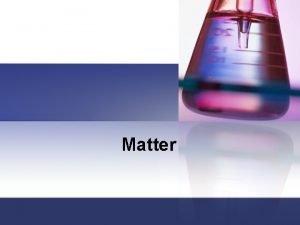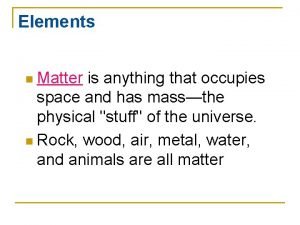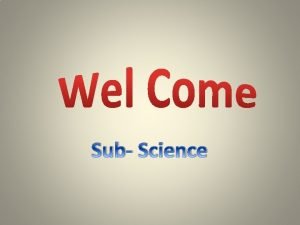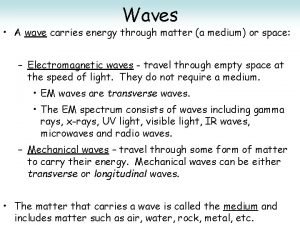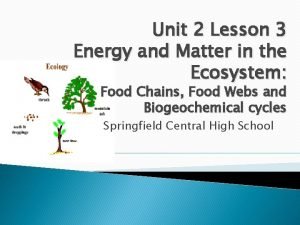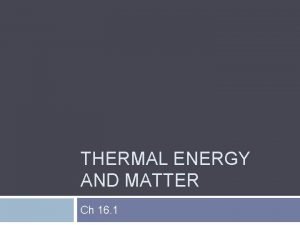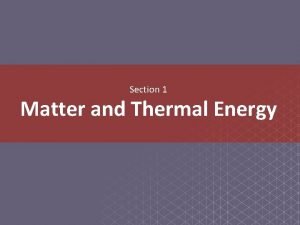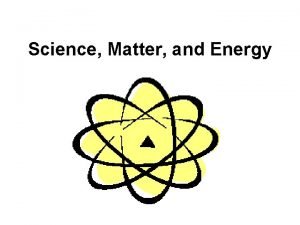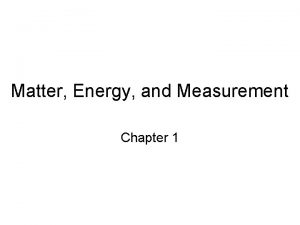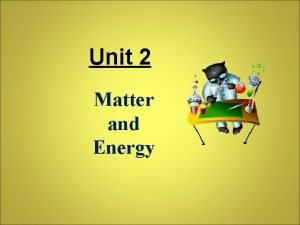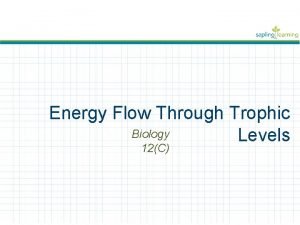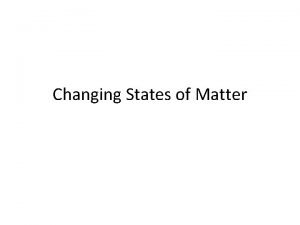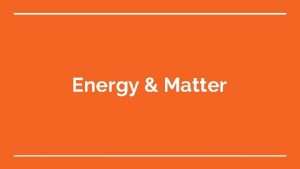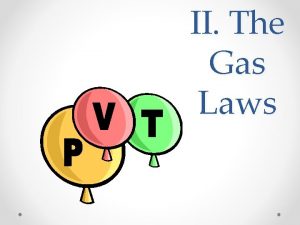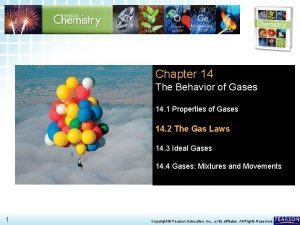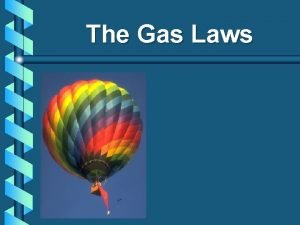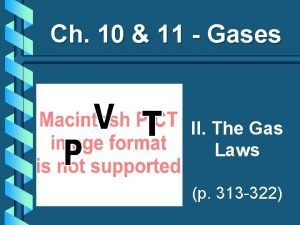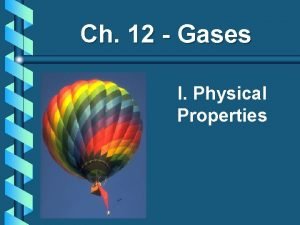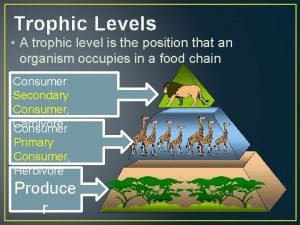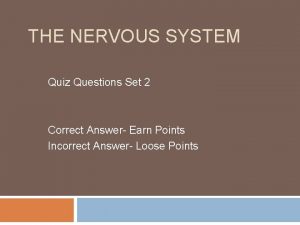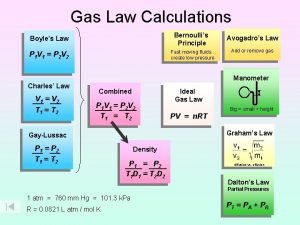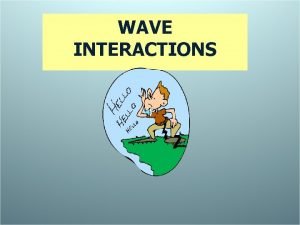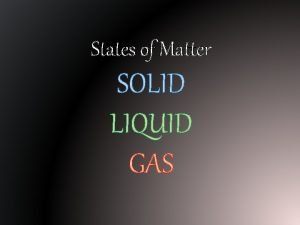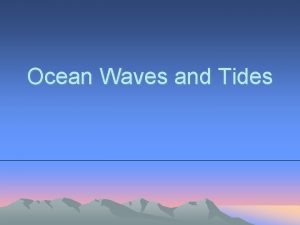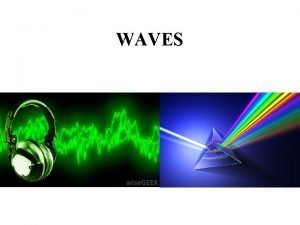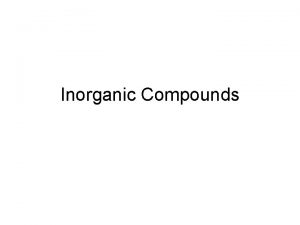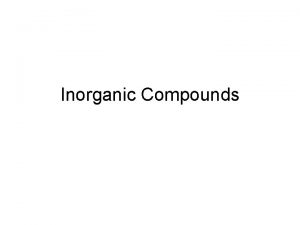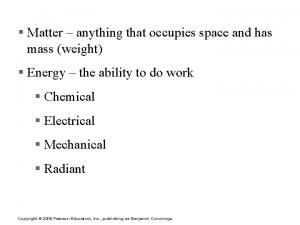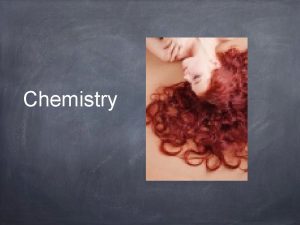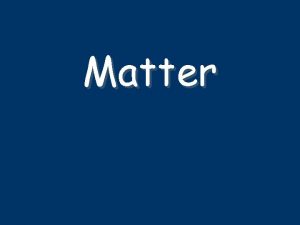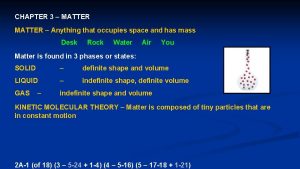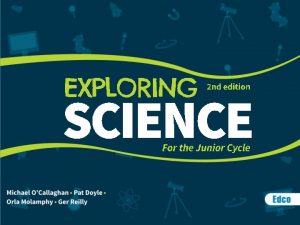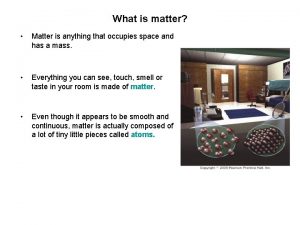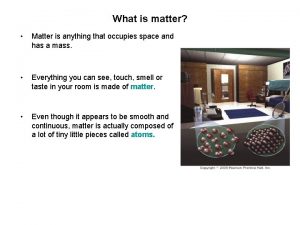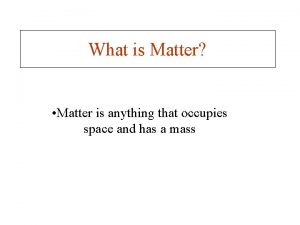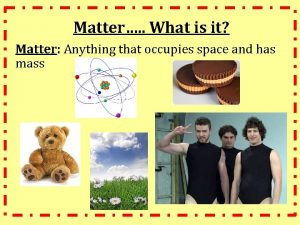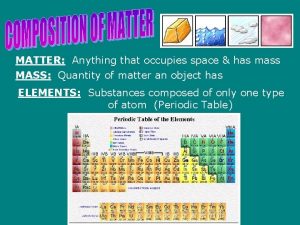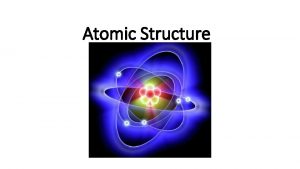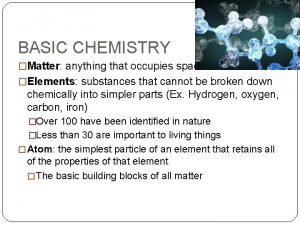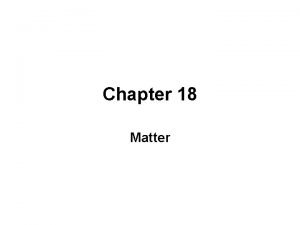Matter and Energy Matteranything that occupies space and































































- Slides: 63

Matter and Energy • Matter—anything that occupies space and has mass (weight) • Energy—the ability to do work, it can be: • Chemical • Electrical • Mechanical • Radiant

Composition of Matter • Elements—fundamental units of matter • 96 percent of the body is made from four elements • Carbon (C) • Oxygen (O) • Hydrogen (H) • Nitrogen (N) • Atoms—building blocks of elements

Subatomic Particles • Nucleus, contains: • Protons (p+) • Neutrons (n 0) • Orbiting the nucleus are: • Electrons (e–) • Number of protons equals numbers of electrons in an atom mostly.

Figure 2. 2

Identifying Elements • Atomic number— equal to the number of protons • Atomic mass number—sum of the protons and neutrons

Isotopes and Atomic Weight • Isotopes • Atoms of the same element with the same number of protons and the same atomic number • Vary in number of neutrons

Figure 2. 3

Radioactivity • Radioisotope • Heavy isotope • Tends to be unstable • Decomposes to more stable isotope • Radioactivity—process of spontaneous atomic decay, used in treatment of cancer

Molecules and Compounds • Molecule—two or more atoms of the same elements combined chemically • Compound—two or more atoms of different elements combined chemically

Figure 2. 4

Chemical Reactions • Atoms are united by chemical bonds • Atoms dissociate from other atoms when chemical bonds are broken

Electrons and Bonding • Electrons occupy energy levels called electron shells • Electrons closest to the nucleus are most strongly attracted • Each shell has distinct properties • The number of electrons has an upper limit • Shells closest to the nucleus fill first

Electrons and Bonding • Bonding involves interactions between electrons in the outer shell (valence shell) • Full valence shells do not form bonds

Inert Elements • Atoms are stable (inert) when the outermost shell is complete • How to fill the atom’s shells • Shell 1 can hold a maximum of 2 electrons • Shell 2 can hold a maximum of 8 electrons • Shell 3 can hold a maximum of 18 electrons

Inert Elements • Atoms will gain, lose, or share electrons to complete their outermost orbitals and reach a stable state • Rule of eights • Atoms are considered stable when their outermost orbital has 8 electrons • The exception to this rule of eights is Shell 1, which can only hold 2 electrons

Figure 2. 5 a

Reactive Elements • Valence shells are not full and are unstable • Tend to gain, lose, or share electrons • Allow for bond formation, which produces stable valence

Figure 2. 5 b

Chemical Bonds • 1. Ionic bonds • Atoms become stable through the transfer of electrons • Form when electrons are completely transferred from one atom to another they are weak bonds as they can easily dissociate in water • Ions • Result from the loss or gain of electrons • Anions are negative due to gain of electron(s) • Cations are positive due to loss of electron(s)1

Figure 2. 6

Chemical Bonds • 2. Covalent bonds • Atoms become stable through shared electrons, they are strong bonds as they never dissociate in water

Figure 2. 7 a

Figure 2. 7 b

Figure 2. 7 c

Covalent Bonds • Covalent bonds are either nonpolar or polar • Nonpolar • Electrons are shared equally between the atoms of the molecule • Electrically neutral as a molecule

Figure 2. 8 a

Covalent Bonds • Covalent bonds are either nonpolar or polar • Polar • Electrons are not shared equally between the atoms of the molecule • Have a positive and negative side or pole

Figure 2. 8 b

Chemical Bonds • 3. Hydrogen bonds • Weak chemical bonds • Hydrogen is attracted to the negative portion of polar molecule • Provides attraction between molecules


Biochemistry: Essentials for Life • Organic compounds • Contain carbon • Most are covalently bonded • Includes carbohydrates, lipids, proteins, nucleic acids • Inorganic compounds • Lack carbon • Tend to be simpler compounds • Includes water, salts, and some acids and bases

Important Inorganic Compounds • Water –Most abundant inorganic compound

Important Inorganic Compounds • Salts • Easily dissociate into ions in the presence of water • Vital to many body functions

Important Inorganic Compounds • 1. Acids • Release hydrogen ions (H+) • Are proton donors • 2. Bases • Release hydroxyl ions (OH–) • Are proton acceptors • Neutralization reaction • Acids and bases react to form water and a salt

p. H • Measures relative concentration of hydrogen ions • p. H 7 = neutral • p. H below 7 = acidic • p. H above 7 = basic • Buffers—chemicals that can regulate p. H change

Figure 2. 12

Important Organic Compounds • Carbohydrates • Contain carbon, hydrogen, and oxygen • Include sugars and starches • Classified according to size • Monosaccharides—simple sugars(glucose) • Disaccharides—two simple sugars joined by dehydration synthesis(sucrose) • Polysaccharides—long-branching chains of linked simple sugars(starch)

Figure 2. 14 a–b

Figure 2. 14 c

Figure 2. 14 d

Important Organic Compounds • Lipids • Contain carbon, hydrogen, and oxygen • Carbon and hydrogen outnumber oxygen • Insoluble in water

Lipids • Common lipids in the human body • Neutral fats (triglycerides) • Found in fat deposits • Source of stored energy • Composed of three fatty acids and one glycerol molecule • Saturated fatty acids contain only single covalent bonds(as butter, solid at room temp. , dangerous) • Unsaturated fatty acids contain one or more double covalent bonds(olive oil, liquid, safe)

Glycerol 3 fatty acid chains (a) Formation of a triglyceride Triglyceride, or neutral fat 3 water molecules Figure 2. 15 a

Figure 2. 16 a

Figure 2. 16 b

Lipids • Common lipids in the human body (continued) • Phospholipids • Contain two fatty acids rather than three • Form cell membranes

Polar “head” Nonpolar “tail” Phosphorus-containing group (polar end) Glycerol backbone 2 fatty acid chains (nonpolar end) (b) Phospholipid molecule (phosphatidylcholine) Figure 2. 15 b

Lipids • Common lipids in the human body (continued) • Steroids • Include cholesterol, bile salts, vitamin D, and some hormones • Cholesterol is the basis for all steroids made in the body

Important Organic Compounds • Proteins • Account for over half of the body’s organic matter • Provide for construction materials for body tissues • Play a vital role in cell function • Act as enzymes, hormones, and antibodies • Contain carbon, oxygen, hydrogen, nitrogen, and sometimes sulfur • Built from amino acids

Proteins • Amino acid structure • Contain an amine group (NH 2) • Contain an acid group (COOH) • Vary only by R groups

Proteins • Fibrous proteins • Also known as structural proteins • Appear in body structures • Examples include collagen and keratin • Stable

Figure 2. 19 a

Proteins • Globular proteins • Also known as functional proteins • Function as antibodies or enzymes • Can be denatured

Heme group Globin protein (b) Hemoglobin molecule composed of the protein globin and attached heme groups. (Globin is a globular or functional protein. ) Figure 2. 19 b

Enzymes • Act as biological catalysts • Increase the rate of chemical reactions • Bind to substrates at an active site

Energy is Water is absorbed; released. bond is H 2 O formed. Substrates (S) e. g. , amino acids + Product (P) e. g. , dipeptide Peptide bond Active site Enzyme (E) Enzyme-substrate complex (E-S) 1 Substrates bind to active site. Enzyme changes shape to hold substrates in proper position. 2 Structural changes occur, resulting in the product. Enzyme (E) 3 Product is released. Enzyme returns to original shape, ready to catalyze another reaction. Figure 2. 20

Important Organic Compounds • Nucleic Acids • Built from nucleotides • Pentose or ribose (5 carbon) sugar • A phosphate group • A nitrogenous base • A = Adenine • G = Guanine • C = Cytosine • T = Thymine • U = Uracil.

Deoxyribose Phosphate sugar Adenine (A) (a) Adenine nucleotide (Chemical structure) KEY: Thymine (T) Cytosine (C) Adenine (A) Guanine (G) Figure 2. 21 a

Nucleic Acids • Deoxyribonucleic acid (DNA) • The genetic material found within the cell’s nucleus • Provides instructions for every protein in the body • Organized by complimentary bases to form a double-stranded helix • Contains the sugar deoxyribose and the bases adenine, thymine, cytosine, and guanine • Replicates before cell division

Hydrogen bond Deoxyribose sugar Phosphate (d) Diagram of a DNA molecule KEY: Thymine (T) Cytosine (C) Adenine (A) Guanine (G) Figure 2. 21 c-d

Nucleic Acids • Ribonucleic acid (RNA) • Carries out DNA’s instructions for protein synthesis • Created from a template of DNA • Organized by complimentary bases to form a single-stranded helix • Contains the sugar ribose and the bases adenine, uracil, cytosine, and guanine • Three varieties are messenger, transfer, and ribosomal RNA

Important Organic Compounds • Adenosine triphosphate (ATP) • Composed of a nucleotide built from ribose sugar, adenine base, and three phosphate groups • Chemical energy used by all cells • Energy is released by breaking high energy phosphate bond • ATP is replenished by oxidation of food fuels

Adenine High energy bonds Ribose Phosphates ) Adenosine triphosphate (ATP) Adenosine diphosphate (ADP) ) Hydrolysis of ATP Figure 2. 22 a-b
 It has a mass and occupies space
It has a mass and occupies space Matter is anything that has
Matter is anything that has Matter is anything that occupies space
Matter is anything that occupies space It is anything that has mass and occupies space
It is anything that has mass and occupies space Energy naturally flows from warmer matter to cooler matter
Energy naturally flows from warmer matter to cooler matter It is anything that has mass and occupies space
It is anything that has mass and occupies space A wave carries
A wave carries A disturbance that transmits energy through matter or space
A disturbance that transmits energy through matter or space Phân độ lown
Phân độ lown Premature atrial contraction
Premature atrial contraction Thể thơ truyền thống
Thể thơ truyền thống Thơ thất ngôn tứ tuyệt đường luật
Thơ thất ngôn tứ tuyệt đường luật Chiến lược kinh doanh quốc tế của walmart
Chiến lược kinh doanh quốc tế của walmart Tìm vết của đường thẳng
Tìm vết của đường thẳng Hãy nói thật ít để làm được nhiều
Hãy nói thật ít để làm được nhiều Tôn thất thuyết là ai
Tôn thất thuyết là ai Gây tê cơ vuông thắt lưng
Gây tê cơ vuông thắt lưng Sau thất bại ở hồ điển triệt
Sau thất bại ở hồ điển triệt Whats gray matter
Whats gray matter Median and lateral apertures
Median and lateral apertures Gray matter and white matter
Gray matter and white matter Telecephalon
Telecephalon Energy energy transfer and general energy analysis
Energy energy transfer and general energy analysis Energy energy transfer and general energy analysis
Energy energy transfer and general energy analysis Classification of matter section 1 composition of matter
Classification of matter section 1 composition of matter Classification of matter section 1 composition of matter
Classification of matter section 1 composition of matter Chapter 2 matter section 1 classifying matter answer key
Chapter 2 matter section 1 classifying matter answer key Classification of matter section 1 composition of matter
Classification of matter section 1 composition of matter All matter has and takes up
All matter has and takes up Turbo molecular pump
Turbo molecular pump Lesson 3 energy and matter in ecosystems answer key
Lesson 3 energy and matter in ecosystems answer key Section 16.1 thermal energy and matter
Section 16.1 thermal energy and matter Section 1 matter and thermal energy
Section 1 matter and thermal energy Science matter and energy
Science matter and energy Matter energy and measurement
Matter energy and measurement Dark matter and dark energy presentation
Dark matter and dark energy presentation Unit 2 matter and energy
Unit 2 matter and energy Trophic level 1
Trophic level 1 The science duo physical and chemical changes
The science duo physical and chemical changes States of matter mind map
States of matter mind map Phases of matter foldable
Phases of matter foldable Similarities of mechanical and electromagnetic waves
Similarities of mechanical and electromagnetic waves Kesler science sound waves answer key
Kesler science sound waves answer key Energy pyramid labeled
Energy pyramid labeled Cartesian space trajectory planning
Cartesian space trajectory planning Space junk the space age began
Space junk the space age began Camera space to world space
Camera space to world space Unscented trajectory chapter 5
Unscented trajectory chapter 5 World space computer
World space computer Sample problem for boyle's law
Sample problem for boyle's law A sample of neon gas occupies a volume of 677 ml at 134 kpa
A sample of neon gas occupies a volume of 677 ml at 134 kpa Are gasses highly compressible
Are gasses highly compressible Pv=k boyle's law
Pv=k boyle's law A gas occupies 473 cm3 at 36°c. find its volume at 94°c
A gas occupies 473 cm3 at 36°c. find its volume at 94°c A gas occupies 473 cm3 at 36°c. find its volume at 94°c
A gas occupies 473 cm3 at 36°c. find its volume at 94°c Divine right theory government
Divine right theory government The position an organism occupies in a food chain
The position an organism occupies in a food chain Within the meninges cerebrospinal fluid occupies the
Within the meninges cerebrospinal fluid occupies the A gas occupies 473 cm3 at 36°c. find its volume at 94°c
A gas occupies 473 cm3 at 36°c. find its volume at 94°c How do waves transfer energy without transferring matter
How do waves transfer energy without transferring matter Thermal energy states of matter
Thermal energy states of matter Rhythmic movement that carries energy through matter
Rhythmic movement that carries energy through matter Oikos meaning
Oikos meaning A rhythmic disturbance that carries energy
A rhythmic disturbance that carries energy

